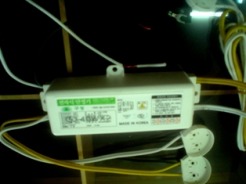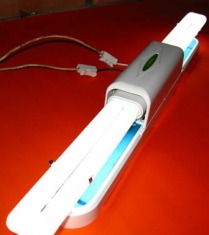In the dark about CFLs?
CFL or Compact Fluorescent Lamp was developed by Ed Hammer, an engineer of General Electric, as a response to the Oil Crisis in 1973. It sought to reduce energy consumption because of the high cost of crude oil prevailing at the time.
There are a number of reasons why the use of CFLs weren’t fully embraced, chief of these was the cost versus prevailing technology; and the growth of economies worldwide which made a seemingly small savings too much of a bother to implement.
The situation today is different.
Global warming due to CO2 emissions, toxic chemicals, and other industrial wastes emitted by rapidly industrializing economies and a growing world population, has brought the planet on the brink of irreversible damage that threatens mankind itself.
Modern technology has developed more efficient and higher energy saving CFLs priced much more affordably. These would generate substantial savings, better lighting, and would allow individuals to contribute towards sustainable ecological preservation and development.
CFL or Compact Fluorescent Lamp was developed by Ed Hammer, an engineer of General Electric, as a response to the Oil Crisis in 1973. It sought to reduce energy consumption because of the high cost of crude oil prevailing at the time.
There are a number of reasons why the use of CFLs weren’t fully embraced, chief of these was the cost versus prevailing technology; and the growth of economies worldwide which made a seemingly small savings too much of a bother to implement.
The situation today is different.
Global warming due to CO2 emissions, toxic chemicals, and other industrial wastes emitted by rapidly industrializing economies and a growing world population, has brought the planet on the brink of irreversible damage that threatens mankind itself.
Modern technology has developed more efficient and higher energy saving CFLs priced much more affordably. These would generate substantial savings, better lighting, and would allow individuals to contribute towards sustainable ecological preservation and development.
Characteristics of CFLs
CFLs are like a smaller fluorescent long bulb with two main parts: the gas filled tube and the magnetic or electronic ballast. The compact tube contains mercury vapor and phosphor. Energy in the form of an electrical current from the ballast flows through the gas, causing it to emit ultraviolet light. The ultraviolet then excites a white phosphor coating on the inside of the tube. This coating emits visible light.
CFLs that flicker when turned on have magnetic ballasts, which may also cause the entire unit to hum. This is wasted energy. Modern technology has developed electronic ballasts that produce instantaneous light, and are more energy efficient than CFLs with magnetic ballasts, and even more than the starter initiated fluorescent tubes of old. Today's CFLs have no need for starters, are brighter and save 35% more energy.
CFLs that flicker when turned on have magnetic ballasts, which may also cause the entire unit to hum. This is wasted energy. Modern technology has developed electronic ballasts that produce instantaneous light, and are more energy efficient than CFLs with magnetic ballasts, and even more than the starter initiated fluorescent tubes of old. Today's CFLs have no need for starters, are brighter and save 35% more energy.
Two types of CFLs are currently available: the integrated ( bulb is fixed inseparably with the ballast); and the non-integrated (ballast and bulb are separate). Most of the integrated CFLs sold in Southeast Asia are fitted with magnetic ballasts. Non-integrated CFLs have electronic ballasts which makes the bulbs more efficient and function for a maximum of 15,000 hours.

Electronic ballasts have a life span of up to 50,000 hours. The latest non-integrated design of CFLs include transformers for the ballasts to absorb current fluctuation; and four pin lights at the base of the bulb to distribute energy more evenly and constantly throughout the tube of the bulb for higher lumen output.
There is a small amount of mercury in CFLs to help them produce light. But this amount is less than one fifth the amount found in a common watch battery. The mercury in a CFL is used to create the light and is totally contained in the fluorescent tube. CFLs are safe in your home.
No mercury is released when the bulbs are in use, and they pose no danger to you or your family when handled properly. An extremely small amount of mercury, an average of five milligrams, is sealed within the glass tubing. For a basis of comparison, there are about 500 milligrams to two grams of mercury in your average home thermometer. It would take from 100 to 400 CFLs to equal that same amount of mercury.
Actually, the greatest health risk is being cut from glass shards. Because there is such a small amount of mercury in CFLs, research indicates that there is no immediate health risk to anyone should the bulb break, especially if cleaned and tidied up well. CFLs should be disposed of properly.
There is a small amount of mercury in CFLs to help them produce light. But this amount is less than one fifth the amount found in a common watch battery. The mercury in a CFL is used to create the light and is totally contained in the fluorescent tube. CFLs are safe in your home.
No mercury is released when the bulbs are in use, and they pose no danger to you or your family when handled properly. An extremely small amount of mercury, an average of five milligrams, is sealed within the glass tubing. For a basis of comparison, there are about 500 milligrams to two grams of mercury in your average home thermometer. It would take from 100 to 400 CFLs to equal that same amount of mercury.
Actually, the greatest health risk is being cut from glass shards. Because there is such a small amount of mercury in CFLs, research indicates that there is no immediate health risk to anyone should the bulb break, especially if cleaned and tidied up well. CFLs should be disposed of properly.






